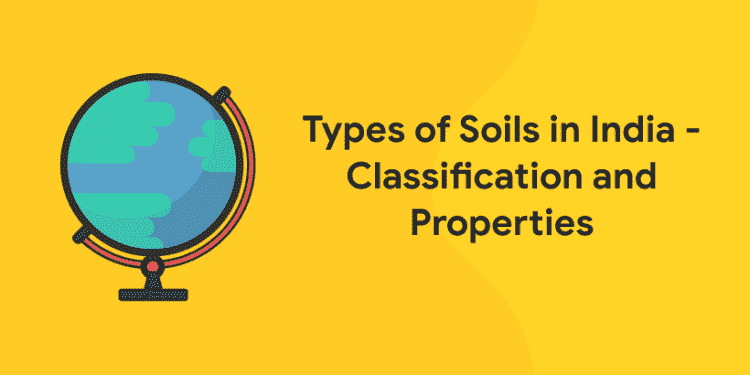Table of Contents
Soil is essential for life as we grow our food in it. But we can’t grow any plant in any soil. There are many types of soils with many plants suitable on it and with their specifications to be fertile and most beneficial. This comes in multiple exams including 10th-grade boards.
Soil Types
We will not be going through all the types but only the major ones. Here are a few common ones of which the first 6 are major soil types found in India.
- Alluvial soils
- Black (or Regur soil)
- Red and Yellow soils
- Laterite soils
- Arid and desert soils
- Saline and alkaline soils
- Peaty and marshy soils
- Forest and mountain soils
Soils and some Information
1: Who was the first woman President of India?
1. Alluvial Soil
Composition: Rich in lime potash, Poor in phosphorous and humus
Formation: Silt brought by rivers
Characteristics: Very fertile, fine-grained both in new alluvium (Khadar) and old alluvium
Distribution: Punjab, Haryana, Uttar Pradesh, Madhya Pradesh, Bihar and West Bengal
Crops: Rice, Wheat, Sugarcane, Cotton, Oilseeds and Jute
2. Black Soil (Regur)
Composition: Rich in lime, aluminium, calcium, potash, iron, magnesium. Poor in nitrogen and humus.
Characteristics: Water retentive cracks develop when dry
Distribution: Maharashtra, Madhya Pradesh, Gujarat, Andhra Pradesh, and Tamil Nadu
Crops: Cotton, Sugarcane, oilseeds and Tobacco
3. Red and Yellow Soil
Composition: Rich in iron, poor in lime, phosphorous, calcium and nitrogen
Formation: Decomposition of granite, gneiss and metamorphic rocks
Characteristics: Not water retentive. When fertilizers are added, soil become productive
Distribution: Tamil Nadu, Kerala, and Karnataka
Crops: Bajra, maize, pulses, potatoes, fruits
4. Laterite Soil
Composition: Rich in iron, poor in lime, phosphorous, calcium, nitrogen
Formation: Leaching of laterite rocks
Characteristics: Agriculturally less important. Bricks are made for house construction
Distribution: Peculiar to India- Andhra Pradesh, Tamil Nadu, West Bengal, and Odisha
Crops: Cashew, Tapioca, Coffee and Rubber
5. Arid and Desert Soil
Composition: Rich in Humus, Nitrogen
Distribution: Western Rajasthan, North Gujarat and southern Punjab
Crops: Only drought-resistant and salt-tolerant crops such as barley, rape, cotton, millets maize and pulses
6. Saline Soil (Reh, Kallar, Usar, Thur, and Rakar Chopan)
Composition: Rich in Chloride, calcium, and magnesium
Formation: Accumulation of soluble salt
Characteristics: Unproductive soil. In Punjab and Haryana gypsum is added to improve the soil
Distribution: Bihar, Uttar Pradesh, Haryana, Punjab, Rajasthan and Maharashtra
Crops: Berseem, Dhaincha and leguminous crops
The following are not so important but extra knowledge doesn’t hurt:
Peaty and Marshy Soils
Marshy soils with a high proportion of vegetable matter also occur in the coastal areas of Orissa and Tamil Nadu, Sunderbans of West Bengal, in Bihar and Almora district of Uttaranchal. The peaty soils are black, heavy and highly acidic. They are deficient in potash and phosphate.
Mountain Soil
Soil Type of Mountains are mainly found in hill slopes and are formed by deposition of organic matter from woodlands and forests. Mountain soils are generally located in the dry and cold districts like Ladakh, Lahaul and Spiti District, Kinnaur District etc. Mountains soils are rich in humus, slightly acidic and are fertile. Mountains soils are also deprived in lime and potash content. They are largely used for raising different varieties of crops.
Forest Soils
Soil Type in Forest is a natural body having depth and surface area. It exists as a continuous cover on the land surface. Only exceptions are steep slopes. The climate of a place affects the forest soils in many different ways. It has led to the development of a variety of soils in India. Essentially, soil is the product of natural destructive and synthetic forces. The physical and chemical weathering of rocks and minerals forms unconsolidated debris regolith. Its upper part is biochemically weathered.
Hope you found that informative and was a good brush up. Continue learning more on the Entri App. Good luck on your exams. Keep learning and Have a nice day! 🙂












